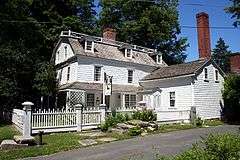Keeler Tavern
|
Keeler Tavern Museum | |
|
Keeler Tavern Museum seen from Main Street. | |
  | |
| Location | 132 Main Street, Ridgefield, Connecticut |
|---|---|
| Coordinates | 41°16′22″N 73°29′50″W / 41.27278°N 73.49722°WCoordinates: 41°16′22″N 73°29′50″W / 41.27278°N 73.49722°W |
| Area | 2.2 acres (0.89 ha) |
| Built | c. 1713 |
| Architect | Benjamin Hoyt et al; Cass Gilbert |
| Architectural style | Colonial Revival, Georgian |
| Website | keelertavernmuseum.org |
| Part of | Ridgefield Center Historic District (#84000817) |
| NRHP Reference # | 82004345[1] |
| Significant dates | |
| Added to NRHP | April 29, 1982 |
| Designated CP | September 7, 1984 |
The Keeler Tavern is an 18th-century historical building at 132 Main Street in the center of Ridgefield, Connecticut, United States. The property served as summer home to architect Cass Gilbert, who purchased it in 1907 and designed additions to the building as well as a garden.
It is also significant for the part it played in the Ridgefield action when British forces passed through, in 1777. The site was placed on the National Register of Historic Places in 1982 and is operated as the Keeler Tavern Museum. It is also included in the Ridgefield Center Historic District, NRHP-listed in 1984.[2]
History
18th century

Around the year 1713, Benjamin Hoyt built the initial structure of the tavern as a home for himself and his family. More than 50 years later, in 1769, the property was purchased by Hoyt's grandson, Timothy Keeler, from his uncle David. Timothy Keeler and his wife Ester converted the building into an inn in 1772, just prior to the beginning of the American Revolutionary War.
The original sign of the inn featured a portrait of King George III of the United Kingdom, which was subsequently painted over with a depiction of a horseman as Timothy Keeler sided with the American revolutionaries. During the Battle of Ridgefield on April 27, 1777, British forces fired on the tavern, because they had learned that the basement of the building was used for making musket balls. One of the British cannonballs lodged itself into a corner post of the building where it has remained stuck ever since.
19th century
In addition to running the tavern, Timothy Keeler was appointed the third postmaster of Ridgefield in 1803 and operated his post office in the tavern. Among the more prominent guests of the tavern were Jérôme Bonaparte, the youngest brother of Napoleon who stayed there with his wife Elizabeth Patterson during their honeymoon.
In 1815, William Keeler inherited the tavern and post office from his father and operated the inn together with his sister Anna as the "W. Keeler's Hotel" until his death in 1827. After his death, his cousin Thaddeus Keeler took over the office of postmaster keeping the post office in the Keeler tavern. When Anna Keeler married Abijah Resseguie in 1829, the hotel was renamed into the "Resseguie Hotel". Anna Keeler and Abijah Resseguie had a single child, Anna Marie, who was born in 1830. After his wife's death in 1862, Abijah Resseguie continued to operate the hotel together with Anna Marie and assisted by Phillis Dubois, a free black woman.
20th century

Cass Gilbert, the celebrated architect, purchased the property from Anna Marie and turned it into his family's summer home in 1907. In doing so, he made various improvements and additions to the building, in particular he designed a Garden House and added a "Charleston Garden" around the year 1910.
The garden is a sunken garden arranged around a reflecting pool with a cherub fountain; it is surrounded by brick walls and arches. When Gilbert's daughter Emily sold the home in 1957, local residents, who wished to preserve the property as an historical landmark, formed a society for its preservation (the Keeler Tavern Preservation Society, Inc.). The society purchased the property in 1965 and opened it as a museum in the next year.
Location
The street address of the Keeler Tavern is 132 Main Street, Ridgefield, CT 06877, USA, across from the fountain in Ridgefield.
See also
References
- ↑ National Park Service (2009-03-13). "National Register Information System". National Register of Historic Places. National Park Service.
- ↑ David F. Ransom and John Herzan (January 16, 1983). "National Register of Historic Places Inventory-Nomination: Ridgefield Center Historic District" (PDF). National Park Service. and Accompanying 28 photos, exterior and interior, from 1982, 1983, and 1984
